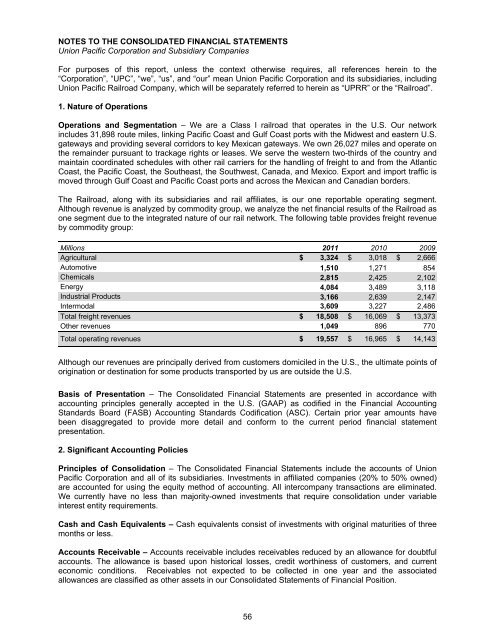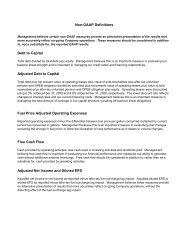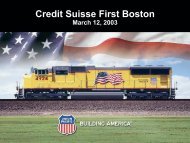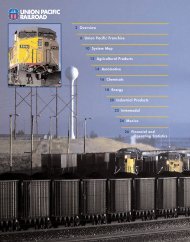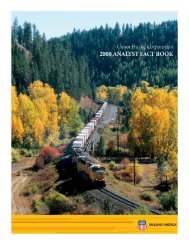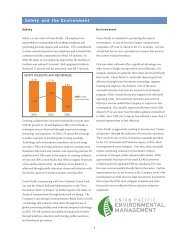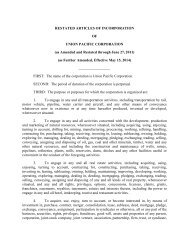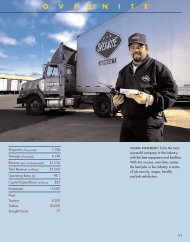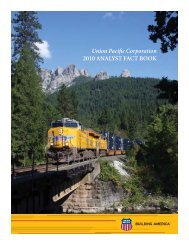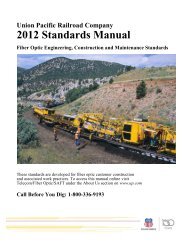Form 10-K - Union Pacific
Form 10-K - Union Pacific
Form 10-K - Union Pacific
You also want an ePaper? Increase the reach of your titles
YUMPU automatically turns print PDFs into web optimized ePapers that Google loves.
NOTES TO THE CONSOLIDATED FINANCIAL STATEMENTS<br />
<strong>Union</strong> <strong>Pacific</strong> Corporation and Subsidiary Companies<br />
For purposes of this report, unless the context otherwise requires, all references herein to the<br />
“Corporation”, “UPC”, “we”, “us”, and “our” mean <strong>Union</strong> <strong>Pacific</strong> Corporation and its subsidiaries, including<br />
<strong>Union</strong> <strong>Pacific</strong> Railroad Company, which will be separately referred to herein as “UPRR” or the “Railroad”.<br />
1. Nature of Operations<br />
Operations and Segmentation – We are a Class I railroad that operates in the U.S. Our network<br />
includes 31,898 route miles, linking <strong>Pacific</strong> Coast and Gulf Coast ports with the Midwest and eastern U.S.<br />
gateways and providing several corridors to key Mexican gateways. We own 26,027 miles and operate on<br />
the remainder pursuant to trackage rights or leases. We serve the western two-thirds of the country and<br />
maintain coordinated schedules with other rail carriers for the handling of freight to and from the Atlantic<br />
Coast, the <strong>Pacific</strong> Coast, the Southeast, the Southwest, Canada, and Mexico. Export and import traffic is<br />
moved through Gulf Coast and <strong>Pacific</strong> Coast ports and across the Mexican and Canadian borders.<br />
The Railroad, along with its subsidiaries and rail affiliates, is our one reportable operating segment.<br />
Although revenue is analyzed by commodity group, we analyze the net financial results of the Railroad as<br />
one segment due to the integrated nature of our rail network. The following table provides freight revenue<br />
by commodity group:<br />
Millions 2011 20<strong>10</strong> 2009<br />
Agricultural $ 3,324 $ 3,018 $ 2,666<br />
Automotive 1,5<strong>10</strong> 1,271 854<br />
Chemicals 2,815 2,425 2,<strong>10</strong>2<br />
Energy 4,084 3,489 3,118<br />
Industrial Products 3,166 2,639 2,147<br />
Intermodal 3,609 3,227 2,486<br />
Total freight revenues $ 18,508 $ 16,069 $ 13,373<br />
Other revenues 1,049 896 770<br />
Total operating revenues $ 19,557 $ 16,965 $ 14,143<br />
Although our revenues are principally derived from customers domiciled in the U.S., the ultimate points of<br />
origination or destination for some products transported by us are outside the U.S.<br />
Basis of Presentation – The Consolidated Financial Statements are presented in accordance with<br />
accounting principles generally accepted in the U.S. (GAAP) as codified in the Financial Accounting<br />
Standards Board (FASB) Accounting Standards Codification (ASC). Certain prior year amounts have<br />
been disaggregated to provide more detail and conform to the current period financial statement<br />
presentation.<br />
2. Significant Accounting Policies<br />
Principles of Consolidation – The Consolidated Financial Statements include the accounts of <strong>Union</strong><br />
<strong>Pacific</strong> Corporation and all of its subsidiaries. Investments in affiliated companies (20% to 50% owned)<br />
are accounted for using the equity method of accounting. All intercompany transactions are eliminated.<br />
We currently have no less than majority-owned investments that require consolidation under variable<br />
interest entity requirements.<br />
Cash and Cash Equivalents – Cash equivalents consist of investments with original maturities of three<br />
months or less.<br />
Accounts Receivable – Accounts receivable includes receivables reduced by an allowance for doubtful<br />
accounts. The allowance is based upon historical losses, credit worthiness of customers, and current<br />
economic conditions. Receivables not expected to be collected in one year and the associated<br />
allowances are classified as other assets in our Consolidated Statements of Financial Position.<br />
56


